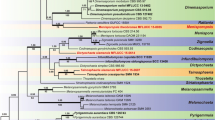Abstract
Ascothailandia grenadoidia gen. et sp. nov. is described and illustrated from submerged wood (Wrightia tomentosa) in a stream at Hala Bala Wildlife Sanctuary, southern Thailand. The new genus (teleomorph) is characterized by perithecoid, globose, dark brown, ostiolate ascomata, paraphysate, asci cylindrical, unitunicate with a prominent J-refractive apical ring and versicolurus, 3-euseptate ascospores. Ascospores germinated producing a Canalisporium (C. grenadoidia sp. nov.) anamorph. The morphological characterization of this new fungus is reported and compared with the genera Ascotaiwania and Savoryella. Phylogenetic analyses of the combined partial 18S, 28S ribosomal DNA and internal transcribed spacer, including 5.8S regions, of Ascothailandia grenadoidia and 10 Canalisporium species were undertaken and analyzed with maximum parsimony and Bayesian methods. The molecular data indicate that A. grenadoidia is closely related to Canalisporiumelegans in the Sordariomycetes, Hypocreomycetidae, order incertae sedis. Both morphological and molecular characterization provides sufficient evidence to support the description of a new genus. A key to Canalisporium species is provided.




Similar content being viewed by others
References
Bunyard BA, Nicholson MS, Royse DJ (1994) A systematic assessment of Morchella using RFLP analysis of the 28S ribosomal RNA gene. Mycologia 86:762–772
Cai L, Tsui CKM, Zhang KQ, Hyde KD (2002) Aquatic fungi from Lake Fuxian, Yunnan, China. Fung Divers 9:57–70
Cai L, Zhang KQ, McKenzie EHC, Lumyong S, Hyde KD (2003) New species of Canalisporium and Dictyosporium from China and a note on the differences between these genera. Crypt Mycolog 24:3–11
Cai L, Hyde KD, Tsui CKM (2006) Genera of freshwater fungi. Fung Divers Res Ser 18:1–261
Chang HS, Hsieh SY, Jones EBG, Read SJ, Moss ST (1998) New freshwater species of Ascotaiwania and Savoryella from Taiwan. Mycol Res 102:709–718
Ferrer A, Shearer CA (2005) New records and a new species of Canalisporium from aquatic habitats in Panama. Mycotaxon 93:179–188
Goh TK, Hyde KD (2000) A new species of Canalisporium from Australia. Mycologia 92:589–592
Goh TK, Ho WH, Hyde KD, Whitton SR, Umali TE (1998) New records and species of Canalisporium (Hyphomycetes), with a revision of the genus. Can J Bot 76:142–152
Hall T (1999) Bioedit a user-friendly biological sequence alignment editor and analysis program for Windows 95/98/NT. Nucleic Acid Symp Ser 41:95–98
Ho WH, Hyde KD (2004) A new type of conidial septal pore in fungi. Fung Divers 15:171–186
Huelsenbeck JP, Ronquist F (2001) MRBAYES: Bayesian inference of phylogeny. Bioinformatics 17:754–755
Jones EBG, Eaton RA (1969) Savoryella lignicola gen. et sp. nov. from water cooling towers. Trans Br Mycol Soc 52:161–174
Jones EBG, Hyde KD (1992) Taxonomic studies on Savoryella Jones et Eaton (Ascomycotina). Bot Mar 35:83–91
Kishino H, Hasegawa M (1989) Evaluation of the maximum likelihood estimate of the evolutionary tree topologies from DNA sequence data, and the branching order in Hominoidea. J Mol Evol 29:170–179
Landvik S (1996) Neolecta, a fruit-body-producing genus of the basal ascomycetes, as shown by SSU and LSU rDNA sequence. Mycol Res 100:199–202
Nawawi A, Kuthubutheen AJ (1989) Canalisporium, a new genus of lignicolous hyphomycetes from Malaysia. Mycotaxon 34:475–487
Nylander JAA (2004) Bayesian phylogenetics and the evolution of gall wasps. Comprehensive Summaries of Uppsala Dissertations from the Faculty of Science and Technology, Uppsala
Page RD (1996) TreeView: an application to display phylogenetic trees on personal computers. Comput Appl Biosci 12:357–358
Sivanesan A, Chang HS (1992) Ascotaiwania, a new amphisphaeriaceous ascomycetes genus on wood from Taiwan. Mycol Res 96:481–484
Sivichai S, Hywel-Jones NL, Somrithipol S (2000a) Lignicolous freshwater ascomycota from Thailand: Melanochaeta and Sporoschisma anamorphs. Mycol Res 104:478–485
Sivichai S, Jones EBG, Hywel-Jones NL (2000b) Fungal colonization of wood in a freshwater stream at Khao Yai National Park, Thailand. Fung Divers 5:71–88
Swofford DL (2002) PAUP*4.0b10: phylogenetic analysis using parsimony (*and other methods). Sinauer, Sunderland, MA
Thompson JD, Higgins DG, Gibson TJ (1994) CLUSTAL W: improving the sensitivity of progressive multiple sequence alignment through sequence weighting, position specific gap penalties and weight matrix choice. Nucleic Acid Res 22:4673–4680
White TJ, Bruns T, Lee S, Taylor J (1990) Amplification and direct sequencing of fungal ribosomal RNA genes for phylogenetics. In: Innis MA, Gelfand DH, Sininsky JJ, White TJ (eds) PCR protocols. Academic Press, San Diego, CA, pp 315–322
Acknowledgments
This research was funded by the Biodiversity and Training Program (BRT R_252057 and R_251009) of Thailand. We would like to thank Prof. Morakot Tanticharoen, Dr. Kanyawim Kirtikara and Dr. Lily Eurwilaichitr at BIOTEC for their continued interest and support. We also thank Dr. Sayanh Somrithipol for providing the Latin diagnosis.
Author information
Authors and Affiliations
Corresponding author
About this article
Cite this article
Sri-indrasutdhi, V., Boonyuen, N., Suetrong, S. et al. Wood-inhabiting freshwater fungi from Thailand: Ascothailandia grenadoidia gen. et sp. nov., Canalisporium grenadoidia sp. nov. with a key to Canalisporium species (Sordariomycetes, Ascomycota). Mycoscience 51, 411–420 (2010). https://doi.org/10.1007/s10267-010-0055-6
Received:
Accepted:
Published:
Issue Date:
DOI: https://doi.org/10.1007/s10267-010-0055-6




